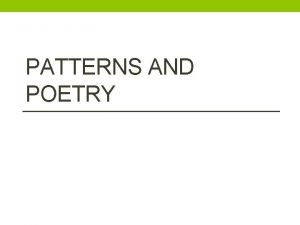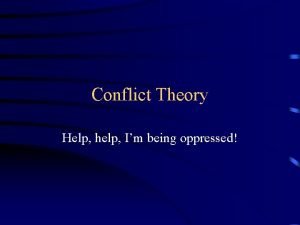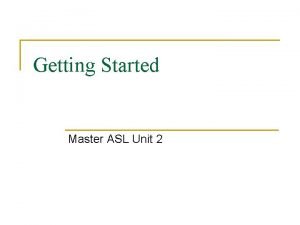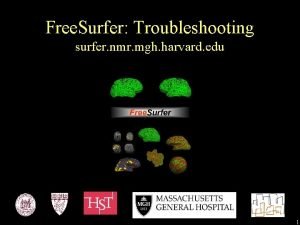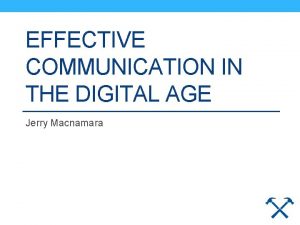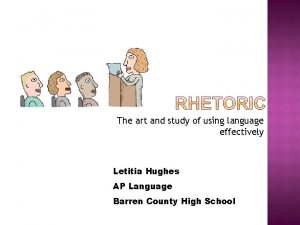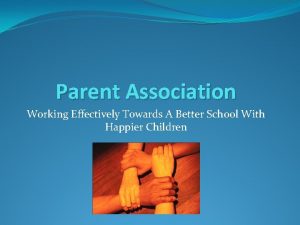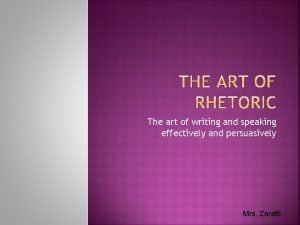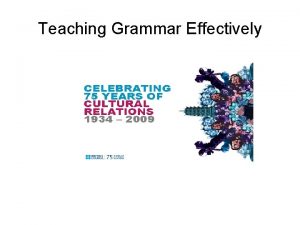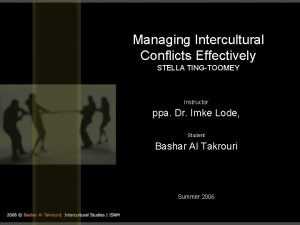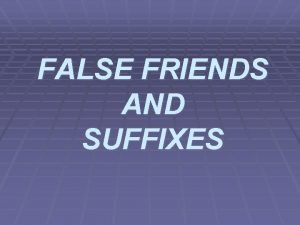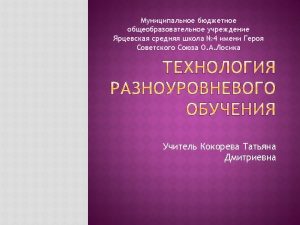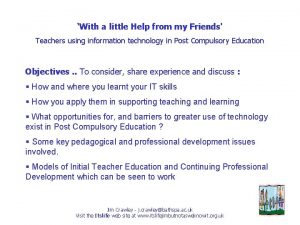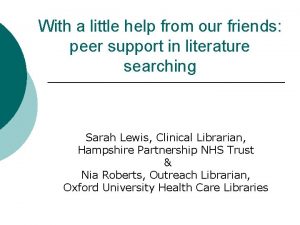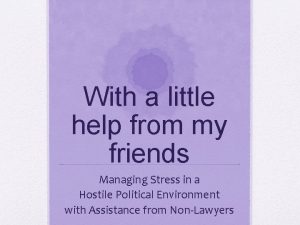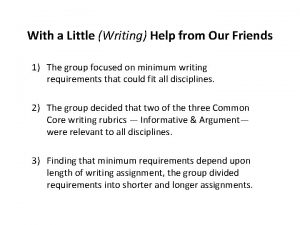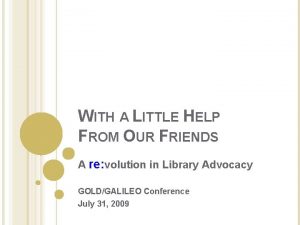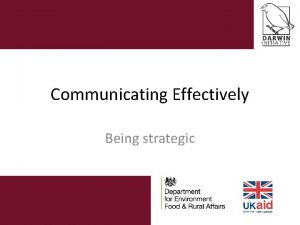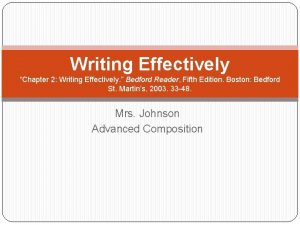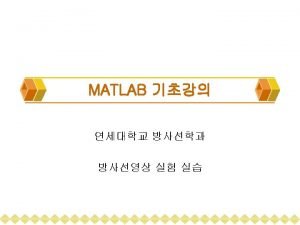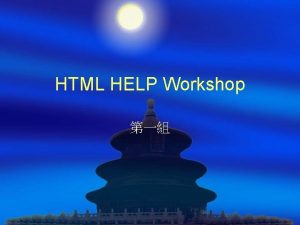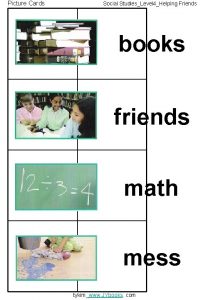With a Little Help From My Friends Effectively



![Congressional Finding [20 U. S. C. § 1400(c)(5)(F)] Almost 30 years of research and Congressional Finding [20 U. S. C. § 1400(c)(5)(F)] Almost 30 years of research and](https://slidetodoc.com/presentation_image_h2/72c06a11860085d6252e258106f54292/image-4.jpg)
























![Letter to Chambers, 59 IDELR 170 (OSEP 2012). Just because the specialized instruction [of] Letter to Chambers, 59 IDELR 170 (OSEP 2012). Just because the specialized instruction [of]](https://slidetodoc.com/presentation_image_h2/72c06a11860085d6252e258106f54292/image-29.jpg)






- Slides: 35

“With a Little Help From My Friends” Effectively Using a Multi-Tiered System of Support (MTSS) for Struggling Students Presented by Paula Maddox Roalson, Attorney at Law


Remember This? The current model guiding special education focuses on waiting for a child to fail, not on early intervention to prevent failure. Reforms must move the system toward early identification and swift intervention, using scientifically based instruction and teaching methods… Education President’s Commission on Excellence in Special July 1, 2002
![Congressional Finding 20 U S C 1400c5F Almost 30 years of research and Congressional Finding [20 U. S. C. § 1400(c)(5)(F)] Almost 30 years of research and](https://slidetodoc.com/presentation_image_h2/72c06a11860085d6252e258106f54292/image-4.jpg)
Congressional Finding [20 U. S. C. § 1400(c)(5)(F)] Almost 30 years of research and experience has demonstrated that the education of children with disabilities can be made more effective by…Providing incentives for whole-school approaches, scientifically based early reading programs, positive behavioral interventions and supports, and early intervening services to reduce the need to label children as disabled in order to address the learning and behavioral needs of such children.

What Does This Tell Us About MTSS? Rt. I is about improving GENERAL education services so that we will have fewer students in our special education program. So although Rt. I comes out of concerns over special education, it is the responsibility of the general education program.

Texas History Prior to referral, students experiencing difficulty in the general classroom should be considered for all support services available to all students, such as tutorial; remedial; compensatory; response to evidence-based intervention; and other academic or behavior support services. If the student continues to experience difficulty in the general classroom after the provision of interventions, district personnel must refer the student for a full individual and initial evaluation. This referral for a full individual and initial evaluation may be initiated by school personnel, the student's parents or legal guardian, or another person involved in the education or care of the student. 19 Tex. Admin. Code § 89. 1011(a)

Resulting Tension There is a natural tension between CHILD FIND and Rt. I. One pulls you toward special education. One pulls you the other way.

The Four Quadrant Analysis

Recent Tension In 2016, The Houston Chronicle publishes its investigation series, Denied. “…officials arbitrarily decided what percentage of students should get special education services — 8. 5 percent… Their efforts. . . denied vital supports to children with autism, attention deficit hyperactivity disorder, dyslexia, epilepsy, mental illnesses, speech impediments, traumatic brain injuries, even blindness and deafness, a Houston Chronicle investigation has found. ” (Emphasis added). Rosenthal, Brian M. (2016, September 10). Denied: How Texas keeps tens of thousands of children out of special education. The Houston Chronicle. Retrieved from:

In 2017, OSEP conducts a monitoring visit of TEA and 12 public school districts in Texas “While the U. S. Department of Education encourages the use of supports for struggling learners that can be delivered in the general education environment, TEA and ISDs within the State have an obligation under the IDEA to ensure that evaluations of children suspected of having a disability are not delayed or denied because of implementation of such supports. OSEP found evidence demonstrating a pattern of practices in ISDs throughout the State in which evaluations were delayed or not conducted for children who were suspected of having a disability because these children were receiving supports for struggling learners in the general education environment. ” Enclosure to Texas Part B Monitoring Visit Letter (OSEP 2017); https: //www 2. ed. gov/fund/data/report/idea/partbdmsrpts/dms-tx-b-2017 -enclosure. pdf

Child Find under the IDEA – What is Required? Each State must have in effect policies and procedures to ensure that all children with disabilities residing in the State, regardless of the severity of their disability, and who are in need of special education and related services, are identified, located, and evaluated. Child find also must include children who are suspected of being a child with a disability under § 300. 8 and in need of special education, even though they are advancing from grade to grade; and highly mobile children, including migrant children. Nothing in the law requires that children be classified by their disability so long as each child who has a disability that is listed in § 300. 8 and who, by reason of that disability, needs special education and related services is regarded as a child with a disability under Part B of the Act.

• In 2018, OSEP releases Final Monitoring Report, finding IDEA child find violations, where students were referred and received services under Section “…the inconsistent interpretation and application of policies and procedures associated with referring a student with dyslexia for special education and related services at the ISD and school levels demonstrates that the State is not meeting its general supervisory responsibility to ensure that ISDs in the State are properly implementing the IDEA child find requirements…That is, if a student is identified with dyslexia, and needs special education and related services under the IDEA, a request for an IDEA evaluation must be initiated. ”

Where Does Section 504 Fit In This Analysis? Section 504 Special Education Under Section 504, a Qualified Person with Disabilities is defined as “any person who (i) has a physical or mental impairment which substantially limits one or more major life activities, (ii) has a record of such an impairment, or (iii) is regarded as having such an impairment. 34 C. F. R. § 104. 3(j)

Recent Cases


W. V. v. Copperas Cove ISD, 73 IDELR 181 (W. D. —Tex. 2018) W. V. was a first grader who qualified for special education as a student with a speech impairment. In the spring of W. V. ’s first grade year, his parent requested special education testing to evaluate for a specific learning disability. The school denied the request for an evaluation and issued Prior Written Notice. However, the school did agree to conduct a dyslexia screening, and upon completion, the student was identified as having dyslexia. The ARD committee incorporated dyslexia instruction and accommodations into the student’s special education program. The next school year, the District conducted a re-evaluation of the student, to include an evaluation for a learning disability. The District reported that the evaluation results would result in the student’s dismissal from special education. The parents immediately requested a special education due process hearing,

The parents alleged that the school district failed in its child find responsibilities and failed to comply with all procedural requirements. The Due Process Hearing Officer ruled in favor of the school on all issues, and the parents appealed. On appeal, the court ruled that the school district violated the procedural requirements of the law by not identifying W. V. as a student with a learning disability due to the dyslexia. However, because the dyslexia services had continued following the parents’ request for a due process hearing, the student was not harmed. Because the student was not harmed, per the Court, the District was entitled to summary judgment. School wins.

Key Quote: “The IDEA’s statutory language explicitly includes dyslexia as a disorder included as an SLD. The District diagnosed W. V. with dyslexia; therefore, the District violated the IDEA by determining in its assessment that W. V. no longer met the eligibility requirements for an SLD and thus was no longer entitled to Special Education or an IEP…”

T. W. v. Leander ISD, 73 IDELR 181 (W. D. —Tex. 2018) During T. W. ’s last semester in high school, his mother requested that T. W. be evaluated for special education. Prior to that time, T. W. , who was a “star athlete on the football team, ” would receive support from his parent, teachers and coaches. He also received accommodations pursuant to a 504 plan, due to dyslexia. Despite the accommodations and additional assistance, T. W. experienced “significant stress” in connection with his school work. “On at least one occasion, T. W. advised a counselor that he wanted to drop out of high school and join the military. ” The District refused the parent’s request for an evaluation, and T. W. requested a due process hearing. Meanwhile, T. W. graduated from high school and received an academic scholarship to attend Howard Payne University. T. W. argued that the scholarship was not due to his academic success but rather was to circumvent NCAA rules prohibiting

After T. W. had already graduated from high school, a Special Education Hearing Officer conducted a full two day due process hearing. Following the hearing, the Hearing Officer denied all of T. W. ’s claims on the ground that T. W. had not demonstrated a need for special education. T. W. appealed that decision, requesting that the court overturn the decision of the Hearing Officer. The Court upheld the decision of the Due Process Hearing Officer, concluding that the administrative record supported the Hearing Officer’s decision that T. W. did not demonstrate he needed special education under the IDEA.

Key Quote: T. W. “alleges he received ‘highly individualized’ oneon-one tutoring from coaches, teachers, and his mother and suggests this attention demonstrates he needed special education and related services through the IDEA … T. W. contends that ‘low test grades were dropped to increase his grades, ’ that ‘answers to tests were corrected before being graded, ’ and that other students did not receive these individualized accommodations. ”

Key Quote: “…the SEHO considered all of these things. Nevertheless, the SEHO concluded T. W. had not demonstrated a need for special education. Specifically, the SEHO reasoned that T. W. had passed all his classes, graduated, was admitted to college and had performed satisfactorily on nearly all state assessments and benchmarks…And contrary to T. W. ’s assertions here, the SEHO concluded the accommodations offered to T. W. were not highly individualized, but rather, were available to other students as needed… …T. W. has not demonstrated he needed special education while he was a student at LISD” (emphasis added). School wins.

Avaras v. Clarkstown Central School District, 73 IDELR 50 (S. D. N. Y. 2018) The court held that the district violated its Child Find responsibility by keeping the student in RTI services for sixteen months. The child received RTI services from November of his kindergarten year all the way through the end of first grade. The school noted that he made some progress and was promoted from K to 1 st grade, but the court pointed out that Child Find applies to students who are passing from grade to grade. Comment: This decision is noteworthy for two reasons. First, it overturns the decision by both levels of hearing officers (NY has a two-tier system) on this issue. This is a clear cut example of judges making educational judgment calls without deference to educational experts. Secondly, it’s one of the few cases that addresses the question of how long RTI should be tried before a referral is made. The court does not give a specific answer to that, but its ruling tells us that 16 months is too long. This is particularly the case since the district did not comply with its own “eight-week cycle” standard for each tier of RTI.

Student v. Northwest ISD, Dkt. No. 254 -SE-0617 (2018) “Under Child Find the school district is charged with monitoring the educational performance of its students…In this case, Student had been identified as having dyslexia and had been receiving Section 504 services to accommodate Student’s disability since 2013. Dyslexia is specifically listed in the federal regulations as a type of condition that may lead to eligibility for special education services…The evidence showed the School District clearly was aware Student had a disability… …Student was achieving passing grades and advancing from grade to grade…However, even with the provision of services under Section 504, Student’s reading level was lagging significantly behind Student’s same aged pers and Student made virtually no progress in reading…during the 2015 -16 school year. The School District documented Student’s reading struggles in Student’s Section 504 records and Student’s Parent explicitly inquired whether Student had a learning disability during a Section 504

Continued “Based upon Student’s struggles with reading during the 2015 -16 school year and Parent’s inquiry about a possible learning disability in March of 2016, the School District had reason to suspect Student may be in need of special education services by March of 2016. As such, the School District should have initiated the special education referral and evaluation process at that point in time. However, the School District did not initiate the special education referral process until October of 2016, a six month delay. ”

Culley v. Cumberland Valley School District, 73 IDELR 170 (3 rd Cir. 2018, unpublished) The court held that the district violated Child Find by finding the student with Crohn’s Disease not eligible. The district offered a 504 plan, rather than identifying the student as having OHI. The rationale was that the disease did not result in a need for specially designed instruction. The court disagreed, citing the IEE that the court described as more thorough and detailed. Comment: Context matters. The student was not doing well in school due to excessive absences and had been expelled due to disciplinary problems. It was after the expulsion that the parents made the Child Find claim.

Student v. Killeen ISD, Dkt. No. 286 -SE-0616 (2017) “Prior to referral, students experiencing difficulty in the general education classroom should be considered for support services available to all students, such as tutorial, remedial, compensatory, Rt. Is, and other academic or behavior support services. If a student continues to experience difficulty after the provision of interventions, district personnel must refer the student for an FIE. A district can violate its Child Find duty by repeatedly referring a student for interventions rather than evaluating the student’s need for special education and related services. ”

Continued “The hearing officer is persuaded by the District’s argument that the STAAR—a test taken on one day of a school year —is not necessarily an indicator that a student is disabled and needs special education. While it is one factor to consider, it is not dispositive. Far more dispositive to the identification issue is Student’s academic performance throughout the entire school year, Student’s grades, and Student’s behavior. ”
![Letter to Chambers 59 IDELR 170 OSEP 2012 Just because the specialized instruction of Letter to Chambers, 59 IDELR 170 (OSEP 2012). Just because the specialized instruction [of]](https://slidetodoc.com/presentation_image_h2/72c06a11860085d6252e258106f54292/image-29.jpg)
Letter to Chambers, 59 IDELR 170 (OSEP 2012). Just because the specialized instruction [of] a student with a disability requires is already part of the general curriculum, considered best practices, or offered to all students with or without disabilities does not mean that such instruction does not constitute special education.

Spring Branch ISD v. O. W. , 72 IDELR 11 (S. D. Tex. 2018) The court upheld the IHO ruling that the district violated Child Find. The court held that the district had adequate information about a possible need for special education by October 8, but did not initiate an evaluation until January 15. This four month delay was too long. By October 8, the student had been sent to the principal’s office five times, was failing a majority of his classes despite his gifted intellect. The district was on notice that the student had ADHD and the mother had requested an evaluation.

E. S. v. Conejo Valley USD, 72 IDELR 180 (S. D. Cal. 2018) The court ruled that the school did not violate its Child Find responsibility. This issue turned on a conversation between the mother and the principal on the day before the student started in kindergarten. The mother later testified that she asked for an IEP in that conversation. The principal denied that and produced an email she wrote to the teacher later that day. The email provided a detailed summary of the meeting with the mother and said nothing about a request for an IEP.

Continued Comment: the contemporaneous documentation by the principal was persuasive to the court. But there is another lesson here. The school could have avoided the Child Find issue if a Prior Written Notice document had been produced by the school. After the meeting with the mother the school held a Student Support meeting. Later in the school year the school had another SST and then a third. At the third SST meeting the school decided to make a referral for a special education evaluation. The district could have provided PWN after either of the first two SST meetings. If that had been provided to the mother, along with a copy of the state’s Procedural Safeguards document, it would have been strong evidence that the district complied with Child Find duties.

Practical Strategies

Putting It All Together School districts have an increased litigation risk surrounding child find requirements under the IDEA. Hearing Officers do not always equate student progress to the absence of disability. This much is clear—Students who are not successful with MTSS or Section 504 accommodations and services should be referred for special education evaluation.

Paula Maddox Roalson Attorney | Shareholder| Houston, Texas proalson@wabsa. com www. walshgallegos. com The information in this presentation was created by WALSH GALLEGOS TREVIÑO RUSSO & KYLE P. C. It is intended to be used for general information only and is not to be considered specific legal advice. If specific legal advice is sought, consult an attorney.
 Little friends may prove great friends
Little friends may prove great friends With a little help from my friends tv show
With a little help from my friends tv show All my friends tekst
All my friends tekst 1 little 2 little 3 little indians
1 little 2 little 3 little indians 1 little 2 little 3 little indian
1 little 2 little 3 little indian Whom should we help
Whom should we help Spagetti poem
Spagetti poem River
River Master asl unit 2 pdf
Master asl unit 2 pdf Help help chapter 1
Help help chapter 1 Education through self help is our motto
Education through self help is our motto Freesurfer troubleshooting
Freesurfer troubleshooting Little man machine
Little man machine Grains sand drops
Grains sand drops Quantifier for fresh air
Quantifier for fresh air Few, a few, little, a little exercise
Few, a few, little, a little exercise A few vai few
A few vai few Complete with these words
Complete with these words Mouse mouse where is your house
Mouse mouse where is your house 2 feet go tap tap tap
2 feet go tap tap tap Adverb of little
Adverb of little Approved chemical sanitizers
Approved chemical sanitizers Jerry macnamara
Jerry macnamara How to use twitter effectively for business
How to use twitter effectively for business Chapter 6 lesson 3 communicating effectively answer key
Chapter 6 lesson 3 communicating effectively answer key How can i memorize things quickly
How can i memorize things quickly The art of using language effectively
The art of using language effectively Working effectively as a parent association
Working effectively as a parent association Reading effectively and efficiently
Reading effectively and efficiently Effective communication
Effective communication The art of speaking or writing effectively
The art of speaking or writing effectively How to report bugs effectively
How to report bugs effectively Instructional aid examples
Instructional aid examples Grammar feedback examples
Grammar feedback examples Stella ting toomey
Stella ting toomey Communication skills definition
Communication skills definition






